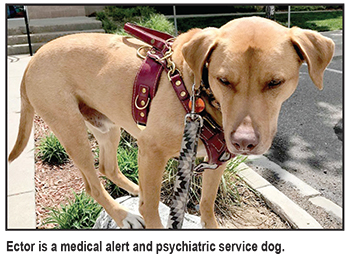
September is National Service Dog Month, which is all about honoring the hardworking dogs that live to assist individuals with varying degrees of disabilities, and who want to achieve as much independence as possible. It’s the perfect time to reflect on the many roles that service dogs play in people’s lives.
This month, once known as National Guide Dog Month, was established in 2008 by Dick Van Patten, an animal advocate, who was “inspired by what he experienced during a life-changing visit to the Guide Dogs of the Desert facility in Palm Springs, CA,” and, as a result, he launched a fundraising drive to benefit guide and service dog training schools throughout the country.
Service dogs can be any breed. Although Labrador Retrievers, Golden Retrievers and German Shepherds are some of the most commonly seen service dogs, absolutely any dog with the proper temperament, good health and the physical capability to assist with their human’s needs can be a service dog.
There are many distinct varieties of service dogs, including, but not limited to: Allergy alert, Autism assistance, Diabetic alert, emergency medical response, guide dogs, hearing dogs, seizure alert and wheelchair assistance.
In the United States, there is no required gear for service dogs. Vests, harnesses and jackets are commonly seen on working service dogs; but, by law, the dog isn’t required to wear anything in order to work in public. However, there are many reasons why service dogs should wear vests.
The single most important reason is that vests mark the dog so there is less confusion in public. This will help save time and effort in many situations, and will keep the dog ready to help if need be. Wearing a vest is also a way many service dogs distinguish working and playing/relaxing. When a service dog is wearing a vest, they are more alert and ready to take action, if necessary.
Additionally, there is no required documentation, registration, certification or paperwork required in order for a dog to be a service dog. While all of the above may be offered by service dog programs, it is not necessary by law.
There are two questions that may be asked to determine whether an animal qualifies as a service animal:
• Is the animal required because of a disability?
• What work or task has the animal been trained to perform?
According to the ADA (Americans with Disabilities Act), the definition of service animal excludes animals that provide comfort and emotional support, but that are not otherwise trained to perform tasks for a person with a disability. Public places remain obligated under both federal and state law to allow service animals to be present.
According to Florida Statute 413.08, “A person who knowingly and willfully misrepresents herself or himself, through conduct or verbal or written notice, as using a service animal and being qualified to use a service animal or as a trainer of a service animal commits a misdemeanor of the second degree, punishable as provided in s. 775.082 or s. 775.083.”
People with a disability have a right to have their service dog accompany them, but businesses and other places where service dogs are allowed, have a right to not have their operations interrupted by a dog who isn’t properly trained. Service dogs must exhibit excellent manners and behavior in public.
Thank you to all service dogs for your hard-work and dedication!
Jo Jo Harder, is a Boca Raton based author, stylist, producer, pet lifestyle expert, CEO and creator of America’s Top Dog Model Contest. Jo Jo has been at the helm of America’s Top Dog Model ® brand since 2005, and her unique approach to discovering, developing, and managing top dog models has gained international attention. America’s Top Dog Model’s new reality series “How to Get to the Top” season one, can be viewed on YouTube. www.americastopdogmodel.com.






